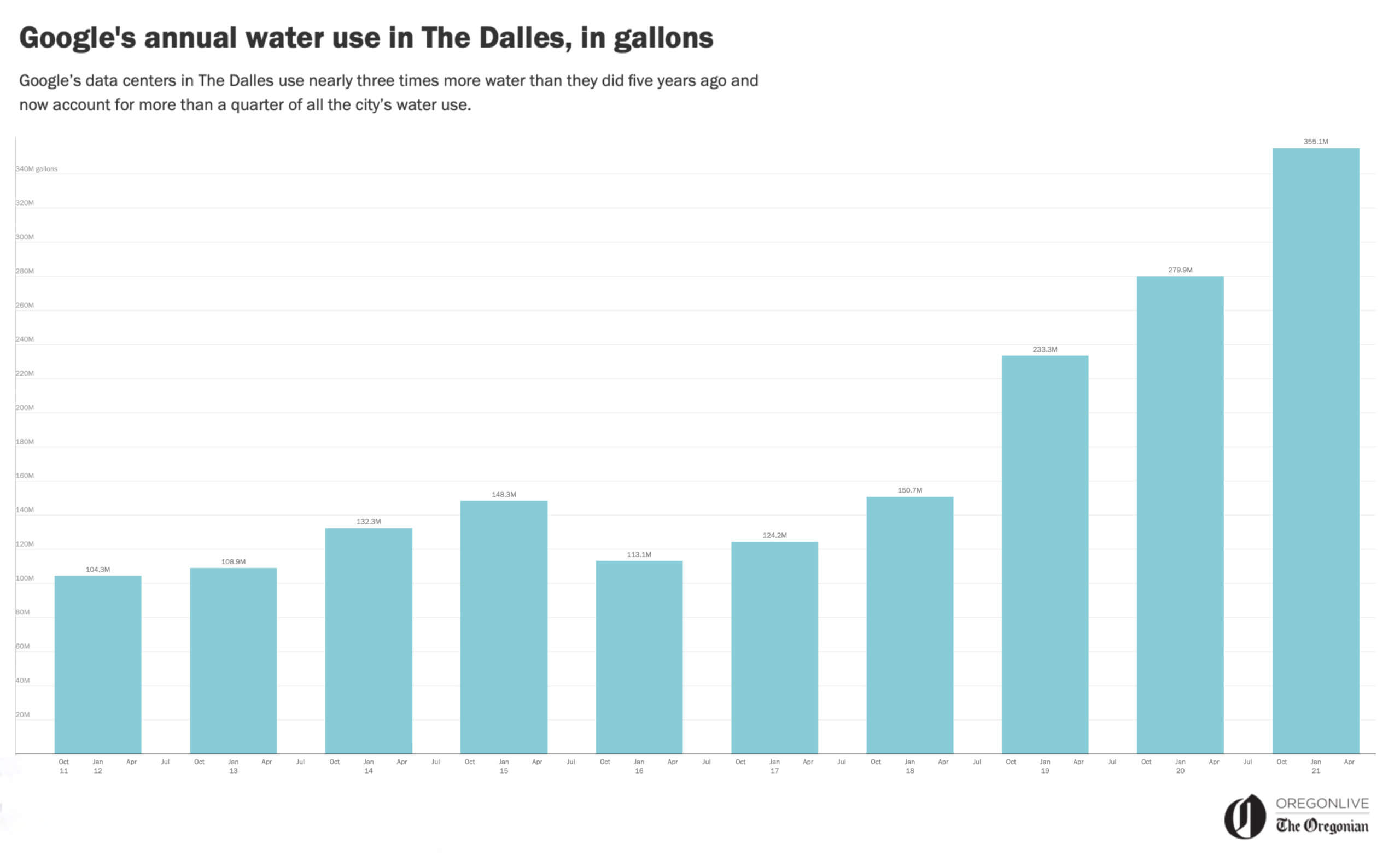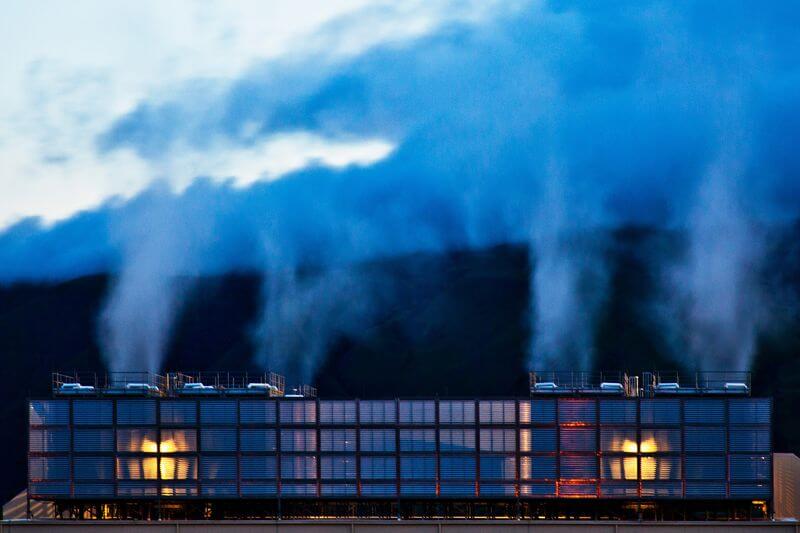By Mike Rogoway | Dec. 18, 2022 | The Oregonian
Google’s water use in The Dalles has nearly tripled in the past five years, and the company’s data centers now consume more than a quarter of all the water used in the city.
That’s according to records released this week after the city settled a lawsuit against The Oregonian and agreed to hand over data on Google’s water consumption. The company’s water use is poised to continue soaring in the years ahead, as Google has plans for two more data centers along the Columbia River.
The numbers illuminate a long-running debate over the future of The Dalles’ water supply, and the potential consequences of Google’s continued growth.
“If the data center water use doubles or triples over the next decade, it’s going to have serious effects on fish and wildlife on source water streams, and it’s potentially going to have serious effects for other water users in the area of The Dalles,” said John DeVoe, executive director of the non-profit advocacy group WaterWatch.
Google and the city maintain that a deal they struck last year, which commits Google to a $28.5 million upgrade in The Dalles’ water infrastructure, is adequate to meet future water needs for both the company and its neighbors.
Google ceded some water rights associated with own industrial land, signing it over to the city — along with the money to upgrade the water system — in exchange for an increased supply of municipal water.
“What we thought was really important was that we partner with the local utility and actually transfer those water rights over to the utility in a way that benefits the entire community,” said Ben Townsend, Google’s global head of infrastructure and water strategy.
Google built its first data center in The Dalles in 2005. It has received tax breaks worth at least $260 million since then. The company has also become an important component of the local economy, without about 200 employees. Its original data center went onto the tax rolls last year after its property tax exemptions expired, generating more than $5 million in local taxes.
The Dalles turned over records of Google’s water consumption this past week after an unsuccessful, 13-month legal fight to keep the information secret. In a settlement with The Oregonian, The Dalles agreed to provide public access to 10 years of historical data on Google’s water use and to honor future records requests.
The records show that Google’s water use is up threefold since 2017, the year before the company opened a third data center in The Dalles. Data centers are packed with hundreds or thousands of powerful computers. The water provides essential cooling, and Google said the increased water consumption reflects the demands of its newest local data center.
Google’s data centers used 355 million gallons of The Dalles’ water last year, 29 percent of the city’s total water consumption. The Dalles, whose name is derived from a French term referencing water flowing through a narrow channel, has a population of about 16,000.
Though it sits along the Columbia River, it’s in a meteorologically dry region, with less than half the annual rainfall Portland receives 80 miles downstream. Water in the Columbia is under federal jurisdiction and generally off limits to new industrial customers.
And like much of eastern and central Oregon, The Dalles has been in a multiyear drought that has farmers, environmental watchdogs and tribal fishers worrying about the future.
“I don’t believe that the best interests in the greater community have been in mind. It’s been more of a short-term economic deal … just to get Google in. And then Google’s become a water vampire, basically,” said Dawn Rasmussen, who lives in an unincorporated area of Wasco County outside the city limits.
Rasmussen isn’t a customer of The Dalles’ water utility, but she said she’s concerned Google’s growth will draw down water storage throughout the area as climate change alters weather patterns.
Last year’s agreement between Google and the city commits The Dalles to provide an undisclosed volume of water to support the company’s expansion. In exchange, Google provided water rights associated with its industrial land, donated 35 acres to Wasco County and paid the full cost of the water system upgrade.
Plans call for developing unused groundwater rights and pumping treated water from The Dalles’ water treatment plant into the city’s main aquifer. That would enable the city to draw from it during dry summer months.
The city says it expects to pump more water into the aquifer than it will withdraw, and projects having more water available for all users — even with Google’s continued growth — than if it didn’t upgrade. But the project generated intense controversy in The Dalles last year, in part because the city refused to say how much water Google was already using.
City attorneys claimed Google’s water use was a “trade secret,” exempt from disclosure under Oregon law, and sued The Oregonian to block the release of the information. Google paid more than $100,000 to fund The Dalles’ legal fight to maintain that secrecy over the past year.
When The Dalles abandoned that effort this past week and agreed to provide the records, it agreed to pay another $53,000 to Reporters Committee for Freedom of the Press, the non-profit organization that represented The Oregonian in the case. Google will also cover those costs.
Google has long maintained a policy of extreme secrecy around its data center operations, a policy it reversed last month as The Dalles moved to settle its lawsuit against The Oregonian. Google, for the first time, disclosed water use at data centers in The Dalles and around the world.
A Google spokesperson said the timing of the company’s reversal on water reporting was probably a coincidence.
The newly issued report showed Google’s data centers used 5.5 billion gallons of water last year worldwide.
Google said it can cool its computers with water or electricity, and in designing its data centers it tries to balance the climate impacts of power consumption against the environmental impact of water use. The company said it works with local hydrologists and local governments to decide how to strike that balance in each community.
In The Dalles, Google said it structured its deal to capitalize on unused water rights to create additional capacity and ensure there’s enough water for residents, the data centers and the nearby water system.
“The (aquifer storage and recovery) project seeks to capture low-hanging fruit that would otherwise be lost and repurpose that for long-term storage,” Townsend said. “We think it’s very important to invest in the long-term health of all watersheds where we operate to make sure that resource is protected.”
Others worry there won’t be enough to go around, with climate change reducing snowpack in the Cascade Range above The Dalles and contributing to a prolonged drought. Elaine Harvey, environmental coordinator for Yakama Nation Fisheries, said that water systems that feed The Dalles may not be adequate if Google keeps growing.
“I don’t believe that there’s going to be enough water for two more data centers in The Dalles, Oregon, if they’re going to specifically take water from that water source,” Harvey said. “This is going to have an impact on the plant life, fish life, wildlife, and the community.”
In its report last month, Google compares the amount of water its data centers use to the amount used by golf courses in the parched American Southwest. By that metric, it says its data centers in The Dalles use the equivalent of 1.8 golf courses.
(The nine-hole golf course at The Dalles Country Club uses about 20 million gallons annually, according to the club, less than six percent of Google’s local water use.)
But WaterWatch’s DeVoe suggests thinking about Google’s water consumption by a different metric. He said Google uses enough water each year in The Dalles to flood the entire city, three inches deep.
Regardless of whether one thinks that’s a lot of water or not, DeVoe said the problem in the area around The Dalles is that water is already in short supply. He said there simply isn’t enough water to add major new users like Google.
“It just upsets the apple cart, because that demand comes on the heels of a fully allocated system and so it becomes really difficult to protect the interests of fish and wildlife in that equation,” DeVoe said.
The Dog River, which drains out of the Cascades south of The Dalles, is of particular concern, according to DeVoe. He said it’s an important water source for The Dalles and has already been under strain as the city’s overall water use has increased, doubling from 2002 to 2021.
The Dog River is home to three endangered fish species, which DeVoe said could be collateral damage as The Dalles thirst continues to increase.
“If the river is going to be de-watered eight or nine months a year, those fish are just out of luck,” he said. “Google is in part cooling its servers with salmon and steelhead.”
This article originally appeared in The Oregonian on Dec. 17, 2022.


